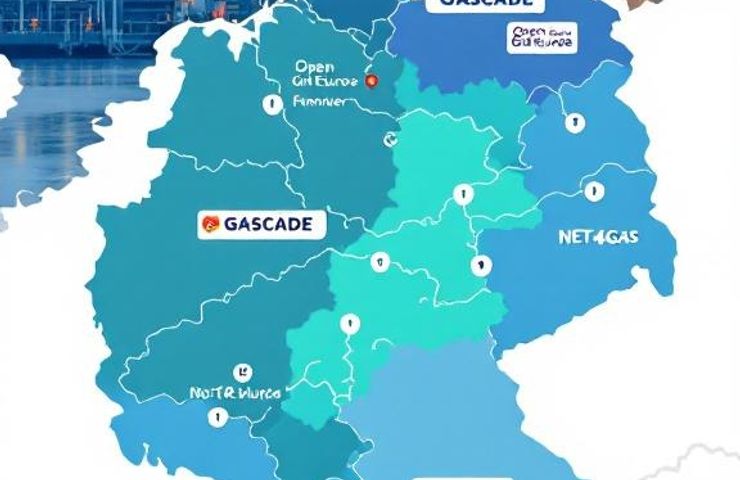
Germany and Czech Republic Launch Bilateral Working Group to Build Cross-Border Hydrogen Infrastructure
November 12, 2025Picture this: those old pipelines that once carried natural gas could soon be buzzing with clean hydrogen. On November 10, 2025, that idea took a big leap forward when Germany and the Czech Republic launched a bilateral working group to map out cross-border hydrogen infrastructure. Their flagship project? The Czech-German Hydrogen Interconnector (CGHI), a plan to give existing pipes new life and link up supply on both sides of the border.
Working Group Takes Shape
This isn’t just a photo-op. Top officials from the German Ministry for Economic Affairs and Climate Action and the Czech Ministry of Industry and Trade are joined by industry heavyweights: GASCADE and Open Grid Europe from Germany, plus NET4GAS and NaTran on the Czech side. Back in April 2025, Berlin and Prague signed a Memorandum of Understanding to kick off planning for the CGHI. Now, they’re set to deliver feasibility studies, nail down technical standards, and sketch out a regulatory roadmap in the coming months.
Retrofitting Pipelines for Hydrogen
Rather than digging fresh trenches, the CGHI will repurpose existing gas lines that straddle the border and convert them into bidirectional hydrogen corridors. Key upgrades include:
- Enhanced internal coatings to ward off hydrogen embrittlement.
- Advanced leak-detection and monitoring systems tuned to hydrogen’s tiny molecules.
- Pressure-management tweaks for safe, high-compression flows.
On top of that, these retrofits lay the groundwork for smarter hydrogen storage solutions to smooth out supply and demand swings. Once live, the CGHI will hook Germany’s budding core hydrogen grid to the Czech Republic’s industrial hotspots, letting clean fuel flow both ways.
Strategic Context and Implications
You can’t talk about the CGHI without mentioning Europe’s energy shake-up since Russia’s 2022 invasion of Ukraine. Germany—always front and center of the Energiewende—bets big on green hydrogen to patch over renewable intermittency and decarbonize heavy industry. The Czech Republic, long reliant on imported fossil fuels, sees this as a chance to secure its future by tapping into western Europe’s sustainable energy networks.
The April 2025 MoU laid out clear goals: synchronize pipeline routes, harmonize technical specs, and fast-track permits. By teaming up on the CGHI, both nations aren’t just building a single link—they’re anchoring their national hydrogen strategies within a wider, pan-European Hydrogen Backbone. That vision, backed by industry and the EU, aims to haul massive volumes of renewable hydrogen across the continent.
Business and Industrial Impacts
The CGHI goes beyond steel and welds; it has the power to reshape markets and supply chains. Here are the big-ticket impacts:
- Energy security: Dual sourcing slashes reliance on any one route.
- Industrial decarbonization: Sectors like steel, chemicals, and refining gain a low-carbon feedstock.
- Market development: Early movers among TSOs and service providers snag a head start in hydrogen logistics.
- Regulatory alignment: A shared safety and tariff framework could set the standard for future cross-border projects.
Sure, retrofitting comes with hefty price tags, and hydrogen demand might not ramp up overnight. Still, having two national governments and leading TSOs in your corner sends a strong signal to private investors.
Next Steps and Roadmap
Here’s the playbook for the months ahead:
- Commission joint feasibility studies, from route planning to technical design details.
- Draft harmonized codes of practice covering manufacturing, installation, and operations.
- Engage EU bodies to tap funding under the EU’s hydrogen and TEN-E programs.
- Set up a regulatory task force to align permitting timelines and ensure smooth cross-border consistency.
If everything stays on track, stakeholders expect a preliminary pipeline design by mid-2026, paving the way for detailed engineering work and permit applications before the end of that year.
Looking Ahead
If Germany and the Czech Republic pull this off, the CGHI could become a blueprint for similar cross-border hydrogen links across Central and Eastern Europe. As governments and private players race toward zero-emission technology, this project offers a tangible step toward a pan-European hydrogen market. Over the coming months, we’ll be watching how the working group tackles technical snags, secures funding, and harmonizes regulations. Nail it, and they’ll open the door to a new era of clean energy integration.


 With over 15 years of reporting hydrogen news, we are your premier source for the latest updates and insights in hydrogen and renewable energy.
With over 15 years of reporting hydrogen news, we are your premier source for the latest updates and insights in hydrogen and renewable energy.